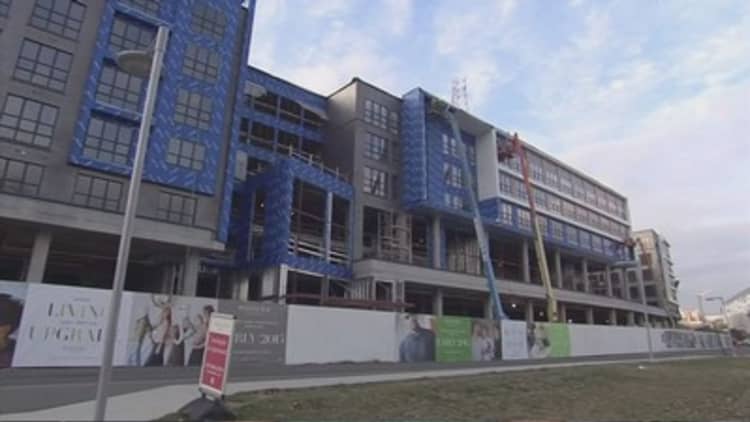
Renters in all price brackets are being handed rent increases, but those at the bottom-end of the housing market are getting hit hardest.
"Rent inflation is consistently higher for lower-cost housing units than it is for higher-cost units," Jonathan McCarthy and Richard Peach, researchers at the Federal Reserve Bank of New York's research and statistics group, said in a recent blog posting.
The researchers examined data from the American Housing Survey's (AHS) national samples for 1989-2013 to estimate inflation rates for rents and utilities, and found "trickle-down" housing may bear the brunt of the blame for socking low-cost renters with proportionally larger rent rises. The AHS survey is done in odd-numbered years.
Read More Think your rent's too darn high? Just wait
The researchers estimate that about 32 million dwellings were added to the market through new construction between 1989 and 2013. About 10.8 million targeted the highest income group, while only around 3.1 million were aimed at the lowest income group, the researchers' full paper said; incomes were divided into five groups.
More new units at the high end likely keeps the vacancy rates there higher, while less competition between tenants for units helps to dampen price inflation in that segment, the researchers said. So even though the actual rent may be higher, it's likely it won't have as large a percentage rise as lower-cost apartments.
This is because at the lower end of rents, supply increases are more likely to come from units that were previously offered at higher rent being pushed down to the next bracket, the researchers said. Those units are still more likely to have higher rents than the housing already in the lower end, pushing up price inflation for that segment, they said. Call it the "trickle-down" effect on rent.
Indeed, during 2011-13, rent inflation in the lowest quintile was nearly 16 percent, but in the highest quintile, inflation was a negative 0.4 percent, the research shows.
It's just another brick in the wall for U.S. renters.
Annual rent growth in September was 5.2 percent, the highest since 2011 and the eighth-straight month the rate has been 5 percent or higher, according to Axiometrics, an apartment research firm.
Overall, U.S. property managers expect to raise rents - possibly by as much as 8 percent next year - as demand rises and vacancies fall, an October survey by property rental website Rent.com found.
Read More This is the next big property investment
The survey found 68 percent of the property managers expect rents will increase next year, while around 88 percent said they raised rents over the previous 12 months. The median asking rent in the U.S. rose by 6.2 percent from $756 a month in the second quarter of 2014 to $803 in the second quarter of this year, data from the U.S. Census Bureau show.
The primary reasons cited for the latest rises were increasing demand and low inventory. Vacancy rates for rental housing nationally dropped to a 20-year low of 6.8 percent in the second quarter, down from 7.5 percent in the year-earlier period, census data show.
Rents and occupancies are currently hovering at historic highs as supply isn't keeping up with demand. While apartment construction has seen strong growth over the past three years, construction of multifamily homes such as apartment buildings fell to next to nothing amid the housing bust, so new units are meeting with pent-up demand.
Permit authorizations for multifamily, or apartment building, construction dropped nearly 15 percent in September from August and are now 1 percent below September 2014, according to the U.S. Census. The vast majority of new supply has been in pricier areas, in particular major urban cores, which has not helped renters in the suburbs or in smaller cities that are in dire need of more affordable rental housing.
More than one in four renters, or around 11.2 million households, were severely burdened by their rent — in other words, spending more than 50 percent of their income on rent — according to 2013 data, up by more than 3 million since 2000, according to research from Harvard University's Joint Center for Housing Studies (JCHS) and Enterprise Community Partners.
Adding in those facing "moderate" burdens — or spending 30-50 percent of income on housing — brings the total proportion of people giving up a serious chunk of their income to rent to just under half of all renters, the JCHS study said.
- Diana Olick contributed to this report.


